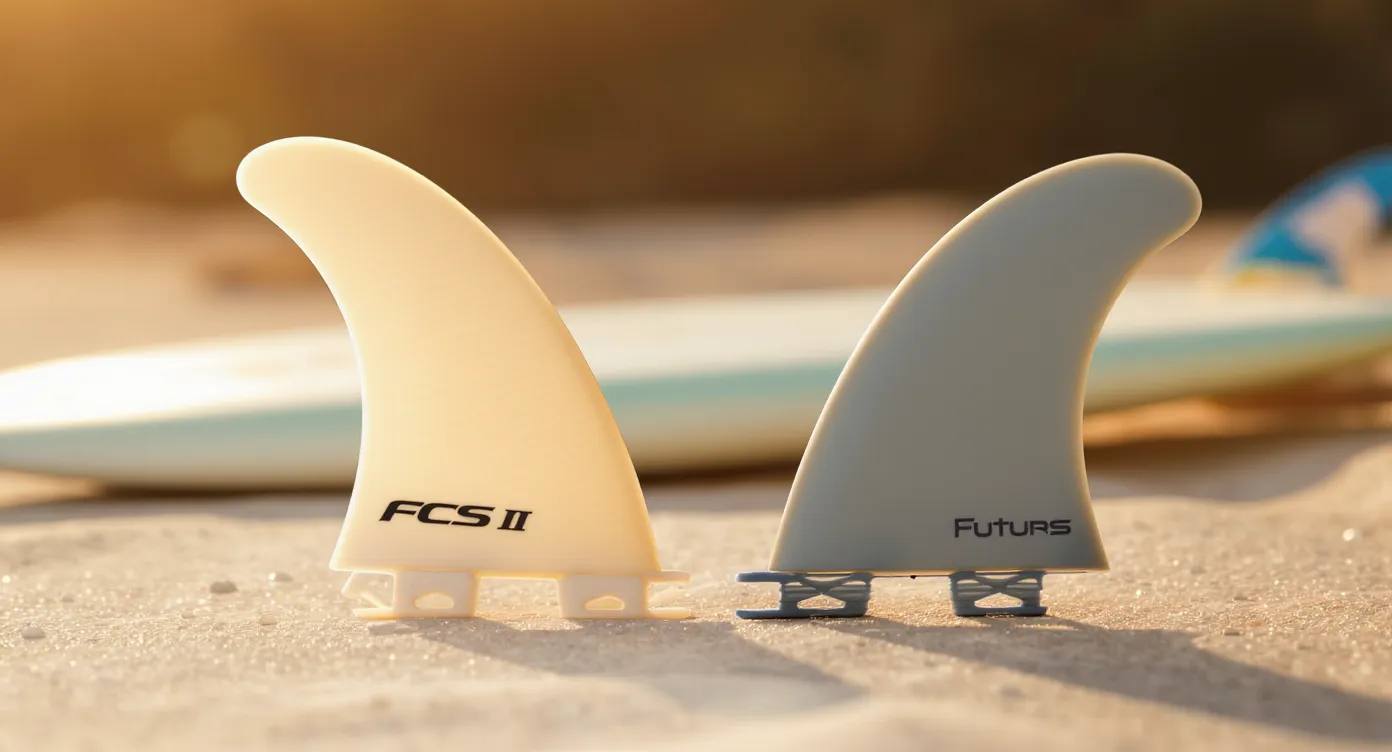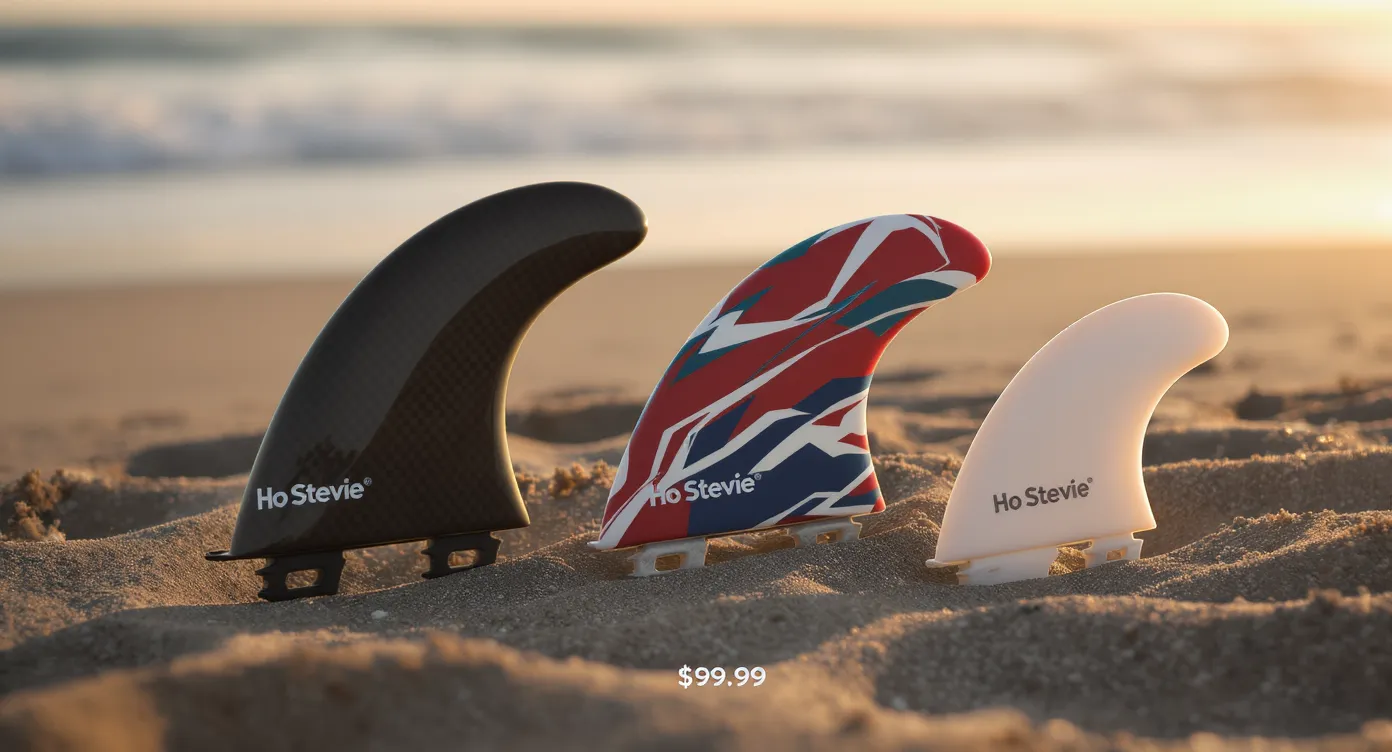You're standing in the shop, staring at two boards. One has FCS II boxes, the other is rigged with Futures. The sales pitch says they're basically the same, but you know better. The fin system you choose changes how your board feels under your feet.
Let's cut through the marketing noise and get clear on when FCS vs Futures fins make the most sense for the waves you surf, whether you're dialing in Huntington closeouts, Gold Coast points, or chilly beach breaks in Cornwall.
The Core Difference: How FCS vs Futures Fins Connect
Everything starts at the base. FCS uses a two-tab system that snaps into the board, while Futures runs a full-length single tab that locks in from nose to tail. That design shift changes how secure the fin feels, how much flex you get, and how power transfers when you push through a turn.
FCS II: Tool-Less Speed and Experimentation
Tool-free install: Pop the fin in, press down, surf. Swapping fins literally takes 30 seconds, which is perfect if you tweak setups based on the day's forecast.
Built for flex: The two-tab connection allows a touch of movement at the base, creating a lively, playful feel in 2–4 foot surf.
Traveler friendly: No need to dig for a fin key in the rental car; you can swap templates in the parking lot or dune without missing a set.
Futures: Single-Tab Power Transfer
One-piece connection: The longer tab creates a rigid interface with the board. There's no wiggle, which means everything you put into your turn goes straight into the face of the wave.
Security first: You do need a fin key, but the box grips the fin from end to end, so there's almost zero risk of a loose fin after a heavy session.
Durability: Why Futures Takes the Win in Heavy Surf
When the swell hits overhead at J-Bay or Puerto Escondido, you want hardware that can take a beating. Futures' single-tab design spreads impact across the entire base, so the fin is less likely to snap or eject.
FCS II tabs can break under serious load. It's the trade-off for that quick-swap convenience. In punchy reef breaks or heavy beachies, plenty of surfers have watched a fin disappear mid-session.
The Feel: FCS for Playfulness, Futures for Drive
Fin feel is ultimately personal, but the systems lean different ways:
- FCS II: Slight flex at the base translates into a looser, more responsive feel. In small summer peaks, that extra release keeps surfing fun.
- Futures: The locked-in base delivers pure drive. In powerful point breaks or bigger winter surf, that connection feels trustworthy and fast.
Fin Selection: FCS Has the Deepest Bench
FCS has been shaping the fin conversation for decades, and it shows. From Filipe Toledo's H4 to Mick Fanning's signature templates, the lineup covers nearly every foil, flex pattern, and material blend imaginable. If you love testing new ideas, FCS makes it easy.
Futures offers excellent options—especially if you want a solid neutral set like the AM1 or Reactor—but the catalog is narrower. You're unlikely to feel limited, yet the granularity just isn't as deep.
Cost: Futures Usually Wins the Long Game
On average, Futures fins come in slightly cheaper than comparable FCS II sets. Factor in fewer broken tabs and replacements, and the budget tips even further in Futures' favor. If you're kitting out multiple boards or dialing in a travel quiver, that savings adds up.
Which System Works Better for You?
Both fin systems rip—it just depends on how and where you surf.
Choose FCS II if:
- You surf mostly small-to-medium waves under 4 feet.
- You love experimenting with different fin setups and templates.
- You want the broadest range of fin designs and materials.
- You value quick changes without digging for a fin key.
- You're not charging serious slabs every weekend.
Choose Futures if:
- You regularly surf bigger, more powerful waves.
- You prefer a locked-in, drive-heavy feel.
- Durability and holding power are top priorities.
- You want confident power transfer through every turn.
- Spending a couple of extra minutes with a fin key is worth the performance.
The Real Problem: Remembering What Actually Worked
The fin system is only part of the story. The real frustration is trying to remember which template delivered when the swell hit six foot and offshore, or which set made that inside beach break suddenly click.
One weekend you love the FCS II Performer thruster in playful Huntington waves. A week later you swap to Futures Reactor quads for a hurricane swell, and they feel magic. Months later you can barely remember which fins matched which conditions.
Stop Overthinking Your Fin Setup
Both systems can unlock incredible surfing—the key is learning what suits your style, board, and home break. Track your sessions, note how each fin template feels, and you'll never stand in a surf shop guessing again.
FinFinder makes that part easy. Log your sessions, note the board, wave size, and which FCS vs Futures fins you ran. Over time you'll build a personalized playbook that tells you exactly when to grab loose, lively FCS II thrusters or confidence-inspiring Futures quads.
Get personalized fin recommendations with FinFinder and bring data-backed confidence to your next surf trip.
Helpful Resources
Ready to Find Your Perfect Fins?
Use our expert fin recommender tool to get personalized suggestions based on your needs.
Try Fin Recommender
